CHAPTER 10
LIQUID SILVER EMULSIONS
PROBLEMS AND SOLUTIONS.
How to Suppress Fog and Degradation of Liquid Emulsions. How to Repair Liquid Light Sensitive Gelatin Silver
Emulsions. How to make tests on Liquid Emulsions for Chemical Fog, Age Fog, and Gelatin Degradation. How to harden the
gelatin in emulsions to stand long wet processing times. How to add antifoggants to improve photo quality.
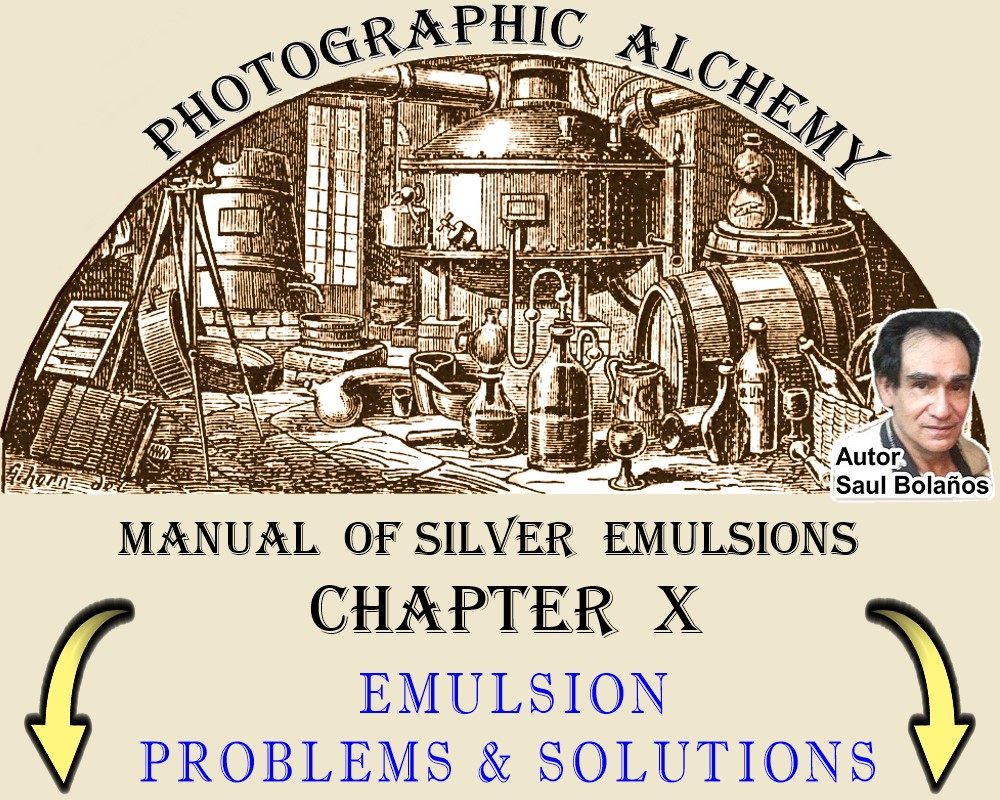
HOW TO SOLVE EMULSION PROBLEMS
Saul Bolaños
Has conducted independent research most of his life on applied Visual Art and Science. He is
an Authority in Liquid Silver Emulsion Chemistry. An Artist and Inventor of Several Novel Printing
Processes, among them Silver Halide Coffee Art.
LIQUID SILVER EMULSIONS
have several known common problems. Solutions or Remedies to these Problems are given below.
The first Problem is Fog, Chemical Fog inherent of the Liquid Emulsion itself.
(not Developer fog, or Fog caused by UnSafe light )
the Second Problem is "Frilling" The emulsion leaving its support in the processing baths.
the third Problem is Biodegradation The spoiling of the silver salts vehicle, The Gelatin, which as any food is prone to spoiling. Note that the decomposition products and micro-organisms of degraded gelatin can also cause fog, loss of contrast and frilling.
Commercial Liquid Emulsions
have still more problems than the ones mentioned above because Liquid Emulsion Manufacturers have failed to invest in
research on how to stabilize their Liquid Emulsion or because They simply do not care to.
Emulsion Speed and Contrast in all types of Liquid Emulsions are far from being stable, speed (sensitivity) is continuously
changing while emulsion is in a humid liquid form. Often speed and contrast are unpredictable in Commercial Liquid
emulsion.
They vary not only from batch to batch or from lot to lot, but from bottle to bottle. Much depending on the "storage
experience" each individual bottle has lived during its lifetime ( diverse shipping and storage conditions)
Excessive heat or drastic frequent temperature changes during storage, besides changing
speed and contrast, can also produce Fog.
Age Fog,
the silver grain grows to undesirable size and it will be developed (in the developer bath) spontaneously without any
exposure to light. The whites in the developed pictures which should be dazzling white in a fresh good liquid
emulsion, show only as brilliant grays at best. This alone is also another contrast reducing factor.
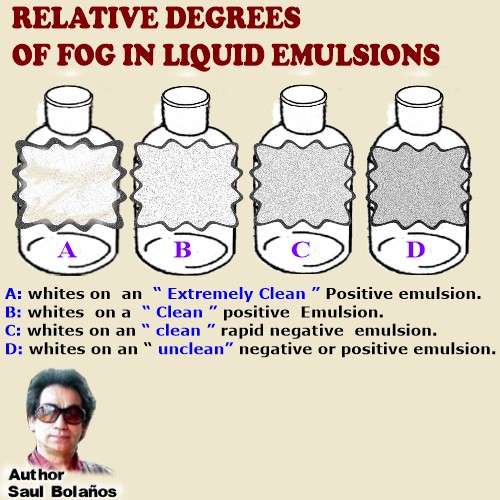 Biodegradation:
Biodegradation:even if liquid emulsion manufacturers add antiseptics to their Liquid emulsion, The gelatin can also begin to spoil under unfavorable storage conditions, half degraded gelatin will loose its mechanical strength.
it will become weak, will Frill when coated and will also fail to protect the silver grain against other types of chemical fog occurring when the silver halide is in humid condition for a long time,
(as in liquid commercial emulsions) On the other hand Most Liquid Emulsion Users are not serious artists. They give up too soon in the first sign of failure. make the emulsion yourself if you do not want to be a victim of bad batches of Commercial Liquid Emulsions, and want full control.
Make the silver emulsion Yourself.
If you are serious artist and are beginning to experiment with Liquid Silver Emulsions, WELCOME ! Let me tell you,
There is no other Medium promising more versatility and chances of success in a career as an artist as the Liquid Silver Gelatin emulsion Process. Once Mastered, it has no rival it is still far superior to digital photography. Your chances of gaining recognition as an artist are 1000%, unless you are lazy.
MIXED EMULSIONS ARE NON TOXIC
There is no liquid Silver Nitrate bath to blacken the skin of your hands, The Liquid emulsion is
non toxic and odorless. Material coated with Trouble Free Fresh Liquid Emulsions have a Long shelf Life and well
processed images can expect to last for hundreds of years. HIGH PEMANENCY: well processed silver chloride and silver
bromide pictures done in the year 1885 are in perfect conditions.
Common commercial liquid emulsion
problems.
HOW TO CHECK FOR BIODEGRADATION:
1. TESTING LIQUID EMULSION WHEN STILL CHILLED
AFTER TAKING OUT OF THE REFRIGERATOR.
Open Liquid Emulsion Containers only in Darkrooms illuminated by adequate Safe Light. Open it very far from the light as
you can. OTHERWISE YOU MAY HAVE TO CONTENT WITH LIGHT FOG.
If Liquid emulsion was kept Under Refrigeration. It should be a very hard solid. If it is not a hard solid, the
gelatin is or has begun to spoil. Shake the Bottle...if
you can hear Liquid Moving inside the container. The Gelatin has spoiled. Before a Chilled, cold stored,
gelatin solution spoils, it begins to liquefy as the coagulating Protein decomposes. Now Open the container in the
darkroom,
if it smells bad, throw it away, Too late. nothing can be done. if the chilled liquid
emulsion, however, is a hard solid (as it should be) It is almost Certain it is in a Healthy Condition, But to learn
how to check for beginning signs of spoiling or gelatin Biodegradation in Liquid Emulsion do this:
Inspect the surface of the emulsion, there should not be mould or spots on the surface which should be of an even
milky white color. If there is mould, but the emulsion is still a solid gel, you can still save it as follows:
Scrape the mould with a plastic or stainless steel spoon... If you can not coat the emulsion immediately (recommended)
after scraping off the mould, To avoid mould in the future, as an antiseptic cover the
solid chilled liquid gelatin emulsion with about an inch above its surface with ethyl
alcohol which is the type people drink...

Gelatin solutions or liquid silver emulsion invariably begin to degrade by the appearance of Mould, at first there is only spores or small black spots on the surface, these penetrate deeper into the gelatin solution and degrade it completely by totally liquefying it even if the gelatin is a chilled as a hard solid (stored under refrigeration).
place the liquid emulsion back in the refrigerator, Use as soon as possible.
Before use, take the alcohol off the surface while emulsion is still in the chilled solid gel
state and before liquefying by heat. Alcohol will not mix with gelatin solution as long as the the latter is
in solid chilled state.
2. TESTING LIQUID EMULSION FOR GELATIN
BIODEGRADATION WITH EMULSION AT ROOM TEMPERATURE.
Gelatins in Liquid Emulsions, Before advancing further, note that liquid emulsion manufacturers use either "SOFT" or "HARD GELATINS" or mixture of both. The average concentration used per every 100 ml of liquid emulsion is anywhere from 7 to 10 grams of gelatin seen as dry weight.
LIQUID EMULSION PRODUCED WITH SOFT
GELATIN:
"Gelitas Ag/ leaf gelatin" MELT AT AROUND; 26-27c
MEDIUM HARD GELATIN SOLUTIONS
MELT AT AROUND: 27-29C
AND HARD GELATINS MELT AT AROUND: 29-30C
Take liquid emulsion out of the refrigerator. If it is in a liquid state it is spoiled, if it is a
solid (as it should be if healthy) Let it come to room temperature for 24 hours. Do this to examine its
mechanical strength in Un-refrigerated chilled condition. Leave it in a cool place away from heat sources or sunlight
of course, for 24 hours. Check the room temperature.
Liquid Emulsions with healthy gelatin should be a solid if room temperature is under 25c. (If in liquid form at 25c, it is
spoiled or beginning to be) -At 20c or below it should definitely be a hard solid gel. If not, the gelatin in the liquid
emulsion is spoiled.
 At 22-24 c
At 22-24 c
it should be a semi solid gel. if emulsion is liquid, the gelatin in the emulsion is probably spoiled.
At 25-26c
a soft gel, or beginning to liquefy.
At 27-29c
or over this temperature the gelatin should be passing into a a full liquid state.
At 33-35c
the gelatin in the emulsion should be (given enough time) as Liquid as Water.
3. MELTING THE LIQUID EMULSION
BEFORE COATING TO TEST FOR CHEMICAL FOG.
Liquefying: Not necessary to melt the whole of the emulsion, Take out only a portion of it
and Liquefy it by placing it inside a glass or stainless steel container. Heat the container holding the portion to be
tested in a hot water bath at 40-45c.
Give it time.
60 ml (2 ounces) of solid emulsion, in good heat conductive vessel like glass or stainless steel should completely
melt in about 5 minutes. Make a habit of never heating liquid emulsion above 50c.
for longer than 5 minutes.
Commercial emulsion about to expire may develop fog in less than 30 minutes at that temperature. The same
expired liquid emulsion may however hold good for 5 hours without fog at 45c ,
and may even be heated 15 hours at 40c without much fog. 40c is a normal coating temperature. Emulsion will be in liquid
form to spread easy.
Coating:
Coat watercolor Fiber paper with a soft brush charged with the emulsion liquefied at 35-40c. water color paper can resist
hours of washing, does not fog silver emulsion and anchors even half spoiled gelatin very well, for those reasons it is the
ONLY recommended medium for beginners to test emulsions on.
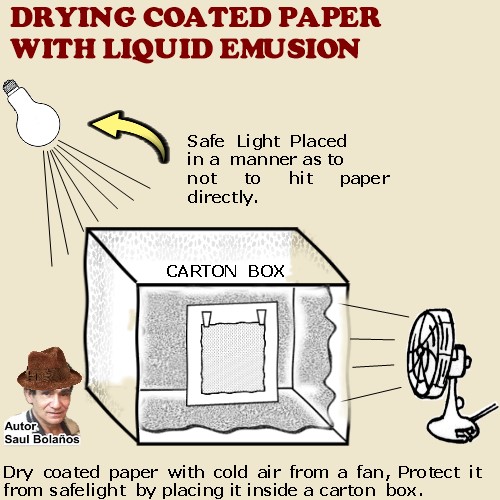 Drying:
Drying:
Dry coated liquid emulsion protecting the paper from exposure to the safelight, IMPORTANT: place a board between the safelight and the paper in a manner that the board shades the
coated paper from direct hit of safelight.
During forced rapid drying of light sensitive material, This is the correct way to dry any coated material in the
darkroom,
MAKE iT A PRACTICE AT ALL TIMES,
You want the purest whites the emulsion can yield and remember, you are testing for emulsion
fog all other sources of fog must be avoided, It is also strongly recommended that you shade the paper in the same
manner while it is the developer solution, after having exposed it.
Coat again, for maximum blacks give the paper a second coat. Dry again very well by placing paper about 10 inches in front
of a current of COLD air coming from a fan.
If you use hot air, on the coated emulsion when it has not yet lost
most of its water, it will melt the gelatin causing the emulsion to run uneven on the paper surface. You will have uneven
tones on development. Grays on those areas where the paper has thinner silver content and blacks or darker grays where
the silver content is higher.
Divide now the paper coated with the liquid emulsion in several strips and keep these in total darkness until needed for
testing. To be Fair, a Recently coated commercial liquid emulsion, or any other freshly prepared liquid emulsion
will be too soft to process immediately after drying,
in tha case The risk of frilling is very high. The gelatin will gain strength to withstand wet chemical processing,
only after 24 hours after the coating has dried, and to be exact
The gelatin will be firmer still after 48 hours, which is the recommended waiting time at the end of
which most applied liquid commercial gelatin emulsion will take the alkali attack of the developer very well without
too much swelling of the gelatin.
For some liquid emulsions formulated with a "soft gelatin" type which tend to develop less fog on long storage,
waiting 72 hours after the coat has dried before processing, may be better still.
Excessive swelling of the Gelatin is one of the reasons it leaves its
support (frilling) the other common reason is poor pre-preparation of the material. Glass for example requires a
first class substrate to hold the emulsion in place during wet processing even with the best of fresh gelatins.
Another words you do not coat liquid emulsions on glass or glazed ceramics with out a subbing layer or substrate because
more often than not the coated film will float off or tear by the time it reaches the acid stop bath.
Paper, because of its fibrous nature can anchored recently coated emulsion quite well with out any substrates. If in the
following tests emulsion frills when processed 24 hours after the coat has dried,
simply waiting another 48-72 hours before processing the coated emulsion may be the solution to avoid frilling for that
particular type of liquid emulsion.
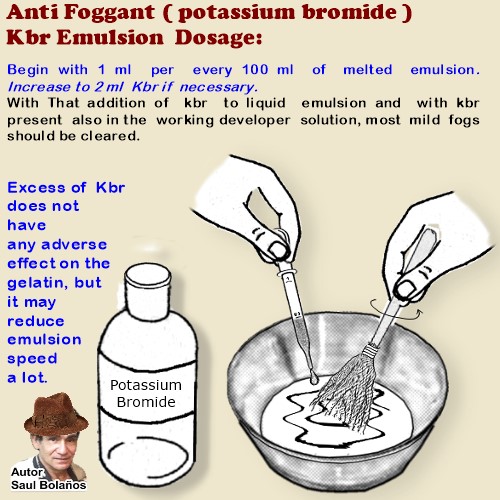 4. TESTING COATED EMULSION
4. TESTING COATED EMULSION
FOR CHEMICAL
FOG AND "FRILLING"
After the coated or applied liquid emulsion has dried on the paper.( preferably after 24 hours ) By in actinic
light, and very far away from the recommended safelight, cut a piece about 1 inch square. Block the paper from direct
hit from safelight with your body at all times. Place a coin on top the sensitive side of the paper.
A) Expose under an actinic light source
(white light) for a few seconds. Careful not to fog any other coated light sensitive material near by. Now take the coin
out of the paper, and process the exposed paper blocking it from direct hit of safelight at all times.
B) Develop the paper by immersing it completely under the
developer solution agitating all the time.
Process or develop the paper in any Paper Developer, Like Kodak's Dektol Paper Developer diluted I:2 with water. For
critical testing Developer temperature should never be above 22c. To be safe develop at 20c.
At 24 c all developers reduce considerable quantities of unexposed silver halide grains, causing
slight fog, THIS IS KNOWN AS DEVELOPER FOG. Develop Pure Silver Bromide or Silver Bromo-iodide Liquid gelatin Emulsions for
no more than 2 minutes. Develop Chloro-bromide Liquid Silver Gelatin Emulsion for no more than 1.5 minutes. Develop Pure
Silver Chloride Liquid Gelatin Emulsions like SILVER CHLORIDE NUMBER 4
SEE CHAPTER 8, for no more than 30 seconds.
After developing the paper for the required time as given for the particular type of liquid silver emulsion, Transfer to a
stop bath.
C) Acid Stop Bath
Use a 1:250 glacial acetic acid stop bath during 3o seconds. (not stronger, emulsion may leave support if too strong,
change bath frequently to avoid yellow stains)
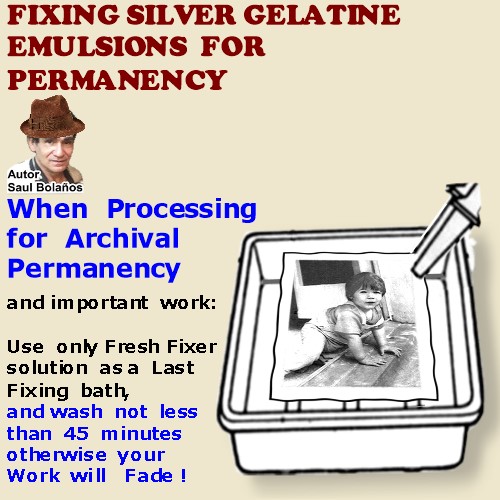 D) FIXER
D) FIXER
Use a hardening fixer
( powder type) during 10 minutes with frequent agitation. Do not overwork this fixer to avoid yellow and brown
patches appearing in the pictures with time. (when processing for archival
permanence and important work Use only fresh fixer as a last fixing bath, so
future generations can see your work )
E) WASHING
Wash the material for 10 minutes without out violent agitation to avoid damage to the emulsion. Do not
use violent water jets. Wash carefully preferably in 6 changes of still clean water, each change lasting 5 minutes is
enough for 90% of all materials.
F) INSPECT FOR FOG
Check for fog, Inspect the whites on the
developed paper under the coin, and compare with the whites of the same paper but without coated emulsion. if the whites
are pure enough, there is no emulsion fog. If the fog is only minimal, reduce developing time about 25%, that should
give cleaner whites if the whites are gray, Liquid Emulsion has Fog. Continue to the next column of this page and add the
antifoggant either to the emulsion or to the paper developer as directed.
INSPECT FOR FRILLING
If the gelatin on the emulsion resisted all the wet processing time without tearing,
without coming off the paper or did not suffered serious damage and held firmly on it, the gelatin in the
emulsion is clean and healthy. No degradation. If the results are not definite. Wait 48 hours and process another
coated paper strip in the same manner, emulsion then will be firmer.
If the gelatin floated off the paper, or it was damaged during the time it was in the
developer, or it was damaged in the stop bath, before it reached the fixer, Bad news. The gelatin employed to formulate the
liquid emulsion is either too soft or it suffered organic degradation. In such case Continue to the next Part of this
page, prepare and add the gelatin emulsion hardeners to the liquid emulsion as directed if the gelatin held good even
in the hardening fixing bath but it was damaged only after washing, Try processing again after 72 hours after the
coated emulsion has dried.
Emulsion Hardeners
You may add any of the liquid emulsion hardeners given below to the liquid emulsion to improve its adhesion and
mechanical strength even if the gelatin is healthy without any biodegradation.
My Antifrilling composition number
1,
is highly recommended for long wet processing times. If you want to make a photographic paper developer as good or
better than Kodak Dektol see formulas. a Hardening fixing bath for photographic films and papers that you can make yourself
are also given in other pages here. Alternative Photography workers and artists will find the Information here extremely
valuable, it will help you make silver prints and silver images of the highest's quality. All formulas have been
tested and used at my MY CAFEGRAFIA LABS.
Additions to Improve liquid Gelatin Emulsions:
ABOUT THE LIQUID PHOTO
Emulsion improver COMPOSITIONS BELOW
The quantity of any of the compositions given below to be added to the liquid gelatin emulsion may be critical. In
excess the chemicals may become a problem instead of a solution Use gloves and avoid breathing chemical dust when
weighting on the scales.
The Liquid emulsion improvers may be added to any type of liquid light sensitive gelatin emulsions, like silver bromide,
silver chloride, silver cloro-bromide, silver bromo-iodide photographic emulsions positive or negative.
Start with dosage given. Test if the Liquid emulsion problem has been corrected or the
emulsion has been improved with the dosage below, if not increase the dosage until it has. Read the warning under each
corrective composition All additions are made while stirring the melted liquid emulsion and mixing completely. Melt the
emulsion in hot water bath at 45c before making the additions. The corrective liquid emulsion compositions found below can
be used by itself or in combination with each other to correct a liquid emulsion fault or defect,
For example:
a liquid photographic emulsion exhibiting two defects
1:
it has fog,
2: it also tends to frill off the support when coated;
in such case, potassium alum may be added to harden the
emulsion gelatin and also potassium bromide, to clear the fog, or instead potassium alum, chrome
alum be added as an emulsion hardener and nitrobenzimidazole as an anti-foggant.
The liquid melted photographic emulsion may also be dosed with an antiseptic at the same time.
When varying the quantities of liquid emulsion, Vary also the amount of the corrective chemical but keep the same
proportions given.
All compositions keep for many years even if stored in bottles not completely full.
For adhesion of liquid silver gelatin emulsions to glass, plastics, glazed
ceramics, etc. you need to apply a subbing layer on the material before coating the emulsion.
1. Liquid Silver Gelatin Emulsion Hardener.
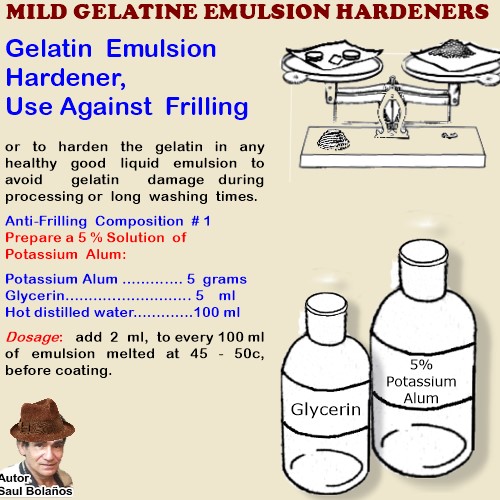 Use AGAINST FRILLING OF LIQUID EMULSIONS
Use AGAINST FRILLING OF LIQUID EMULSIONS
or to harden the gelatin in any healthy good liquid emulsion to avoid gelatin emulsion damage during processing or long
washing time.
Anti-frilling composition
number 1:
Prepare a 5% Solution of
potassium alum:
Potassium Alum ........5 grams
Glycerin..................... 5 ml
Hot distilled water.....100 ml
dosage: 2 ml, per every 100 ml of emulsion melted at
45-50c
The glycerin is there to avoid excessive hardening of the gelatin. Without it, the hardened gelatin on
long storage would repel the developer solution with probable loss of contrast. Blacks would not be maximum.
Over hardening may also cause up to 100% loss of emulsion speed for the same reason. Full emulsion hardening with the
dosage given is only effected after 48-72 hours after the coated liquid emulsion has dried on the material. It should
resist, after that time, (with careful processing) fixing in a plain fixing baths without hardeners. If not, increase the
dosage and test after 72 hours. If you change brand of liquid emulsion you may have to re-test to find the optimum dosage
for the new type gelatin.
Uncoated emulsion may be stored in liquid form after the addition of anti- frill composition
number 1, and the gelatin can be re-melted as normal.
2. Strong Liquid Silver Emulsion Hardener
Use this composition on liquid emulsion which show a great tendency or a high degree of "frilling", or where the
gelatin has begun to bio-degrade or spoil floating off its support during processing.
Anti-frilling composition number
2
Prepare a 5% solution of chrome alum:
Chrome Alum........................... 5 grams
Hot distilled water.....................100 ml
dosage:
1 ml, per every 100 ml of emulsion melted at 45-50c
Chrome alum
is by far a much more energetic as an gelatin emulsion hardener than Potassium alum. Double the dosage given if
necessary. But be Careful, too much will make the gelatin as thick as chewing gum. The hardening effect of Chrome alum can be seen immediately after the coated liquid emulsion has dried on its support, It
will withstand the wet processing much better. But its maximum hardening effect can only be attested after at least 72
hours. (read below)
Excessive chrome alum ( more than 2 ml x 100 ml of emulsion) will not allow the liquid
uncoated emulsion to be re-melted as usual in a hot water bath, if this happens, then the dosage of chrome alum is too
excessive. Above dosage should be a good very safe start. Excess of chrome alum will also
make the liquid hot melted emulsion thicken, to make it thin you may add to every 100 ml of liquid emulsion about O.5 ml of
glacial acetic acid.
If this happen you better coat it all while it is still in its liquid hot melted phase, and process it as soon as possible.
The coated emulsion may be so over-hardened it may loose emulsion speed and some contrast for same reason given above under
anti-frill composition number 1.
WARNING:
effects of "over hardening" of the liquid emulsion can really be seen after the
coated emulsion has been in the dried state for about 7 days, image will not develop even under the developer solution. If
this happens, pre-soak the material for 1-2 minutes in plain water before immersing it in the developer solution, and,
reduce the emulsion hardener dosage of course.
3.Mild Liquid Emulsion
Anti-Foggants,
Use AGAINST fog on LIQUID SILVER EMULSIONS Add it to the developer, to the emulsion, or
to both.
Anti-fog composition number
1
Prepare a 10% solution of Potassium Bromide
Potassium Bromide.................. 10 grams
cold distilled water.................... 100 ml
Dosage:
1 ml, to every 100 ml of working developer solution, should be about right for mild
emulsion fog. Double the amount for a stronger fog , if that does not clear the fog off the whites of the picture add
the potassium bromide to the emulsion also.
ADDED TO THE EMULSIONS: Dosage:
begin with 1 ml per every 100 ml of melted liquid emulsion with That addition of potassium bromide (kbr/potassium bromide)
to liquid emulsion with kbr present also in the working developer solution, most mild fogs should be cleared.
Excess of potassium bromide does not have any adverse effect on the gelatin, but it may
reduce emulsion speed considerably. It is better to have less emulsion sensitivity without fog, than more speed with fog
which always degrades the whites of the pictures lowering also emulsion contrast. o suppress or eliminate a heavier emulsion fog while at the same time raise the emulsion contrast use anti-foggant number 2, as found in next composition. Nitrobenzimidazole is a powerful anti-foggant.
4. Strong Liquid Emulsion
Anti-Foggant,
AND CONTRAST IMPROVER Use AGAINST fog on LIQUID SILVER EMULSIONS Add it to the developer, to the emulsion, or to both.
 Anti-fog composition number 2
Anti-fog composition number 2
Prepare a 0.5%
solution
of 5-6, Nitrobenzimidazole nitrate
also known as (kodak) antifog # 2
5-6,nitrobenzimidazole
nitrate... 0.5 grams
boiling distilled water........70 ml
ethyl alcohol...................... 30 ml
stir for as long as it takes for the benzimidazole to dissolve completely It may take a long time.
DOSAGE:
per every 100 ml of melted liquid emulsion start with 2 ml, coat dry and test. the whites should be very clean with a
marked increase incontrast. If not, duplicate the dosage and test again. Excessive dosage of benzimidazole has no
adverse effect on the gelatin, but it will reduce maximum emulsion speed with a dramatic gain in contrast for most emulsion
types.
If emulsion looses too much speed, reduce dosage. On silver chloride gelatin emulsion like My CHLORIDE number 4, even
small optimum dosages may shift the developed tone from a neutral black to a blue black. Note that Benzimidazole is so
effective as an anti-foggant and contrast improver that most of the time it is not necessary to add it to the emulsion,
enough if added to the developer solution only. thus:
DOSAGE to developer solution:
start with 1 ml, per every 100 ml of working developer solution. Reduce dosage if emulsion speed is considerably
lowered, increase dosage if fog is not completely cleared.Note: “ Benzotriazole “ although not being
exactly like benzimidazole, ( if benzimidazole is not availabble) it can be used instead of the benzimidazole in about the
same proportions given and for same purposes. Benzotriazole or “ Benztriazole “ is much easier to obtain, is available even
in large pharmacies.Nitrobenzimidazole clears fog caused by aldehydes and prevents arial oxidation fog during developing
Molecular Compositions of Nitrobenzimidazole and Benzotriazole are seen above.
5. Liquid Emulsion Antiseptic and fungicide
Use to prevent Mould on LIQUID UNCOATED SILVER GELATIN EMULSIONS Add it to the liquid emulsion melted at 40-45c.
Antiseptic number 1
Prepare a 10%
alcoholic solution of salicylic acid
Salicylic Acid.............................. 10 grams
ethyl alcohol............................... 100 ml
salicylic acid may be added to liquid gelatin emulsions that have to be kept in uncoated
liquid form for a few weeks to prevent gelatin degradation. It may be added also when the coated emulsion can not be
rapidly dried, as in very humid weather where it would take coated material more than 12 hours to dry spontaneously. Note
that emulsion coats that remain humid for too long on its support and are not dried in less than 36 hours will suffer.
Speed may change, fog may appear, spots may develop and contrast will be reduced. For quality work make sure the coated
material dries in less than 12 hours.
Here is one more reason why it is better to apply several thin coats on different emulsion coating sessions and
drying in between each coat, than 1 single heavy coat that will take too long to dry and worse still it may never be
completely fixed by the thiosulphate, which is fatal for permanency.
DOSAGE: 3 ml per
every 100 ml of melted liquid emulsion.
Above dosage will keep in good condition an uncoated liquid gelatin emulsion at room temperature (20-27c) without
refrigeration for at least 30 days. (in 40 days mould may appear) Under refrigeration (5-10c) that dosage will conserve
it about 4-6 months without fungi, spores, or mould. Note that excessive salicylic acid will hydrolyze the gelatin ON
EMULSIONS KEPT UNCOATED IN LIQUID FORM HIDROLIZATION IS KNOWN when gelatin solutions will liquefy with out heat) if kept at
room temperature too long. (but not under refrigeration) Excessive salicylic acid may lower contrast a little on liquid
emulsions formulated with "hard" gelatins because the drop on the emulsion pH and the gelatin emulsion hardness
hinder the developer solution from penetrating deeply into the emulsion layer.
6.HYPER-SENSIBILIZATION
of Liquid Light Sensitive Silver Gelatin Emulsions
Add this to the liquid emulsion melted at 40-45c. to at least double emulsion speed.
hypersensibilizator number 1
Prepare a 10% solution
of sodium sulphite
Sodium sulphite anhydrous........10 grams
boiling water............................... 100 ml
If you have any doubts about the type of sodium sulphite you have, just make it anhydrous by heating it strongly over a
heating element of your oven until it dehydrates. You will know it has no more humidity when you see no water vapor leaving
the crystals. Do this also for the sodium carbonate. (another alkali hyper-sensibilizator found further below)
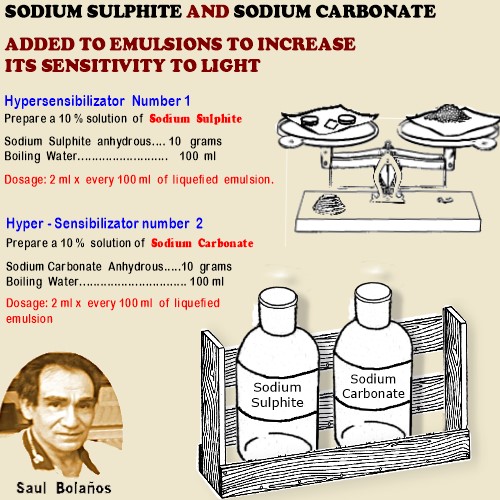 DOSAGE: 2 ml
DOSAGE: 2 ml
per every 100 ml
of melted liquid emulsion.
Above dosage will about double the speed of any clean working silver bromide, silver chloride or any other silver halide
liquid emulsion. Mix completely with emulsion. Doubling the given dosage may or may not increase emulsion sensitivity
or speed further, only testing can determine it.
Note that excessive excessive alkali salts added to the liquid emulsion while increasing its speed even further may also
add fog or a tendency of the gelatin to frill on supports like glass, in such case the gelatin hardeners (given above) as
anti-filling agents may also have to be added. Add this to the liquid emulsion melted at 40-45c. to at least double its
speed.
hyper-sensibilizator number 2
Prepare a 10% solution of
sodium carbonate
Sodium carbonate anhydrous.....10 grams
boiling water............................... 100 ml
If you have any doubts about the type of sodium carbonate (washing soda) you have, just make it anhydrous by heating it
strongly over a heating element of your oven until it dehydrates. You will know it has no more humidity when you see no
water vapor driven by the heat out of the crystals.
DOSAGE: 2 ml per every 100 ml of melted liquid
emulsion. Above dosage will about double the speed of any clean working liquid light sensitive gelatin emulsion.
Increasing dosage further may also increase emulsion speed. read warning on hypersensibilizator number 1 above. Note that
excessive alkali salts added to the liquid emulsion while increasing its speed even further may also add fog or a tendency
of the gelatin to frill on supports like glass, in such case the gelatin hardeners given above as anti-filling agents may
also have to be added.
1ml each of 10% sodium carbonate and 10% sodium sulphite may be added together to every 100 ml
of melted liquid emulsion at 45c. Dosage may also be increased, find optimum dosage by trial and error for the
particular type or brand of liquid emulsion you are using.
7. Testing "Coated" Emulsion For Chemical
Fog and Frilling
After the coated or applied liquid emulsion has dried on the paper. (preferably after 24 hours) By inactinic light,
and very far away from the recommended safelight, cut a strip of the paper of about 1 inch square. Block the paper from
direct hit from safelight with your body at all times. Place a small coin on top the sensitive side of the paper.
A) Expose the piece of paper under an actinic light source
white light for a few seconds. Careful not to fog any other coated light sensitive material near by. Now take the coin out
of the paper, and process the exposed paper blocking it from direct hit of safelight at all times.
B) Develop the strip of paper by immersing
it completely under the developer solution agitating all the time. Process or develop the paper in any Paper
Developer, Like Kodak's Dektol Paper Developer diluted I : 2 with water. (or D72 / see) For
critical testing Developer temperature should never be above 22 c. To be safe develop at 20 c. At 24 c all
developers reduce considerable quantities of unexposed silver halide grains, causing slight fog. This is Known As
“Developer Fog.
Developing Times for Different Types of Emulsions
at 20c Silver Bromide and Silver Bromo- iodide Emulsions for no more than 2 minutes. Chloro-bromide for no more than 1.5
min Pure Silver Chloride. about 40 seconds.
C) Acid Stop Bath
Use a 1:250 glacial acetic acid stop bath dilution during 30 seconds. Not stronger, emulsion may leave support if acid is
too strong. Change bath frequently to avoid yellow stains. If frilling occurs use Hardening Stop Bath, in which case a
plain acid non hardening fixer can be used.
D ) Fixer
Use a hardening fixer ( powder type) during 10 minutes with frequent agitation. Do not overwork this fixer to avoid yellow
and brown patches appearing in the pictures over time.
6. Emulsion & Processing Faults
A. Emulsion Melts or Softens: Processing solutions too hot.
Above 25 c / 77 f, emulsion will soften. At 30 c / 86 f, it will melt.
B. Emulsion peels off or blisters in stop bath: Improper
subbing or pre-coating of material. emulsion not firm enough on the material. Wait 24 hours after coating before
processing.
C. Blistering or frilling in wash water emulsion holds well
during processing but is damaged during washing, the cause is that the hardener in the fixer is exhausted, (make as fresh
bath) insufficient hardening time or wash water too hot or wash time too long.
STAINS Yellow or Orange appearing immediately in the fixer or detected as soon as the image is dried. These are developer stains. Acid stop bath is exhausted and /or developer is overworked or oxidized turning yellow (or developer too old)
Stains Type: 1 Brown or Purple spots or
blotches: Insufficient fixing time. Fixer is overworked, too weak or diluted. Not enough agitation during fixing.
Stains Type: 2 Dark orange and / or yellow spots. appearing
after some time. Not enough washing.
Stains type: 3 Dark brown, purple, dark orange and/or yellow
spots with some parts of the image turning sepia after a few days or weeks while other parts are fading or in the process
of bleaching:
In Type 3 Stains; the effects of type 1 and type
2 stains are combined due to two causes :
1. Not enough fixing time 2. Fixer partially exhausted and not enough washing. To prevent all
of these Stains, observe the following:
2) Do not coat material to thick and coat
as even as possible. b) always use a last fresh unused fixer bath for 5 minutes. c) wash at least 30 minutes.
Emulsion HAND Coating Faults
Coat liquid emulsion on most objects, with a brush, no other method is recommended for beginners. Silver emulsion is Best
Applied with the softest hair brush you can find. To serve as an example here I give the steps of how I coat stones with
silver liquid emulsion. (after applying white primer and subs, which see). coating Stones for
a permanent image over time is the most difficult task because of the stone's uneven sufrace. Here is how i
solved it.
 First
coat:
First
coat:
very thin and even. Then Place STONE in front of a current of cold air from a fan (see fig) After about 5 minutes, when
fist coat is hard enough to resist, Second Coat is applied also very thin over the first one. ALWAYS USE A SOFT BRUSH.
Dry a little again in front of the fan for another 5 min. and apply a third, dry with cold air again to set the coat and
apply a fourth.
Always leave an Even & Thin coat of emulsion with care as not leave thick pools of emulsion which will not be dissolved
completely in the fixing bath, which is the most common fatal ERROR comitted by 99%
of the cases.
Do not coat stones by dipping in the emusion if you want your grandchildren to see the work.
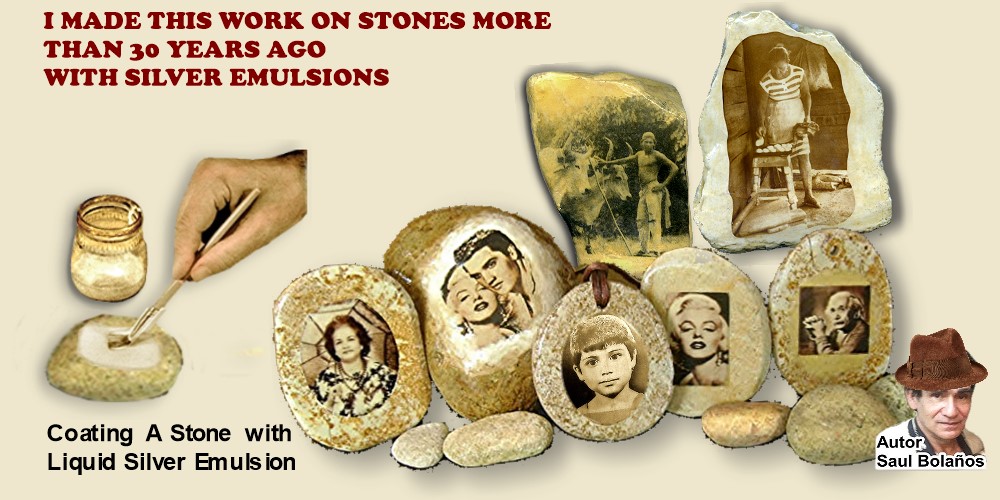
1. HAND Coating Error #
1
Thick Uneven Pools of Emulsion " This common error is the Number One failure of Liquid
Emulsion users. Unfixed silver is still light sensitive and will darken on exposure to light sooner or later,
appearing as dark blotches or spots, in a period of 24 -72 hours for bad cases or worse still after a few months or years
when you have no longer power to correct it.
For this reason when coating all materials I do not flow the emulsion on it or dip it in a pool of emulsion; as recommended
by some liquid emulsion manufacturers, That is Fatally catastrophic to say the least. For
beginners Brush is much safer, and entirely satisfactory, it leaves thin and even layers that will fix rapidly and
completely in about 5 minutes in the thiosulfate fixer. (positive emulsions with low iodide content) But leave
instead a total time of 10 minutes in the fixer.
The extra 5 minutes are needed for the hardener in the fixer to harden the gelatin in the emulsion fully so it can stand
careful washing without damage. Glass plates can be coated by “flowing“ but only when leaving a known quanta of emulsion.
2. "PROCESSING" Error # 1
“ Overworking the Fixing bath “ If you want your grand children to see your silver
prints: always use a fresh (unused) fixer as your last bath. For important Work "Use used Fixer as a First Bath: 5
minutes, but the Second 5 minute Bath has to be unused Fresh Fixer.
Conditions Affecting Emulsion Speed & Contrast
Poor Contrast can be caused by: not enough agitation or temperatures too high during
precipitation and ripening of the emulsion, Also by coating emulsion too thin, by overworked developer, stale coated
material, emulsion overheated or left too long out of refrigerator. Over exposure during printing of the negative. After
drying, coated emulsion feels a little sticky This occurs only with UNWASHED EMULSIONS coated on impervious non porous, or
non absorbent materials like glass, painted metals, glazed ceramics, plastics,etc. It is due to Potassium , Ammonium or
Sodium Nitrate left in emulsion attracting humidity from air.
REMEDY: apply warm air or heat a little until coat no longer feels sticky and while it is still
warm; pack each plate or object immediately inside plastic bag (or wrap in cellophane ) so it will not absorb more humidity
from air. Pack each coated object or plate individually so they will not damage each other or stick together. It does not
occur in porous materials because the humid salts sink into the fibers.
Speed Changes Contrast , and Maximum Blacks
May depend on emulsion thickness. 2 thin brush coats make good pictures as long as they
cover the surface evenly. They yield less Speed and contrast however than thicker coats made for example with 4 thin coats
instead of 2,
There is a limit where thicker coats will not yield denser blacks or more speed and contrast. After this limit has been
reached, further coats will make the layer harder to fix , the image may not have optimum sharpness and the whites may be
less pure.
Coating Weight of Emulsion on Glass

Leave about 5 ml of emulsion
on a plate size: 9 x 12 cm
(about 100 cm2)
Use this ratio and proportion for any other size.
250 ml
(half pint)
of emulsion
should coat about
50 plates of that size.
Glass Plate shown Here
Size 34 x 50 Millimeters
Should be Coated with
0.80 ml of emulsion
Temperature for Making Ammonia Emulsions
 with any type of gelatine, to avoid fog and obtain clear and clean highlights Eder correctly identified that the
mixing of ammonia emulsions should be under temperatures of 40c.
with any type of gelatine, to avoid fog and obtain clear and clean highlights Eder correctly identified that the
mixing of ammonia emulsions should be under temperatures of 40c.
Some ammonia emulsions given by other workers in a later date than 1880 in other books, call for temperatures higher than
40c and longer heating or first ripening times,
That is because they had pre-tested their gelatins by making a few trial with the same emulsion formula and found they
could stand the higher temperatures and longer digesting or heating times without producing heavy fog.
These type of gelatine which allow temperatures above 40c, are not common and have high dosages of natural retarders in
higher amounts than normal. Some gelatins produce fog even under 40c particularly if the first ripening or digesting time
is too long.
(15 to 45 minutes) The only way to test a type of gelatin for speed, fog and contrast is by making an emulsion and My
emulsion formula # 1 is by far the best one to start the test with.
Not to go over 35-38c is the safest temperature for the first trial. On
a second batch: a temperature of 45c can be tried to see if more speed is gained and to compare the amount of fog (if
any).
IMPORTANT:
To Eliminate Traces of Ammonia After Washing
The more the emulsion is left in contact with the ammonia, the more difficult it will be to wash it out completely. It is
advised to Prolong emulsion washing times by 50 % or so when First Ripening time is prolonged.
On Re-melting washed emulsion, it is normal to detect a slight odor of ammonia, which disappears after a few minutes as the
gelatine absorbs it without any harm, if the detectable odor of ammonia is too strong or if it persists more than 10
minutes after re-melting:
Add 1 ml of Glacial Acetic Acid in 10 ml of water.
per every 10 grams of Silver Nitrate used to make the emulsion. That quantity of acid
will neutralize the ammonia when it is present in moderate amounts. Continue then to Second Ripen as normal STRONG PRESENCE
OF AMMONIA AFTER WASHING WILL PRODUCE STAINS OR FOG DURING DEVELOPMENT.
if after melting the washed emulsion and adding the acetic acid as given earlier, the emulsion after standing 10-15 min
still smells strongly like ammonia, bad news.
Emulsion was not correctly washed, But do not panic. Just set again in ice water bath until very firm just like the first
time, shred and wash again with 4-6 changes of ice water. To every 2.5 liters of washing water
add about 1ml of a 10 % solution of potassium bromide which will prevent fog just
in case the emulsion is over washed.
Before washing, the emulsion has free bromide which washes out faster than the ammonia, if all free bromide is lost in the
emulsion by excessive washing it may leave the silver in excess which will cause fog in alkaline development;
the free bromide added to the washing water will prevent this from happening. In this way emulsion can be washed as long of
necessary to get rid of the ammonia without danger.
(Always keeping wash water 5c or below) To Avoid Fog by Over washing add Free Bromide To the Washing water:
add 2 ml of a 10% potassium or ammonium bromide solution to every 5 liters of washing water.
 One more important thing, As said earlier; gelatin has affinity for ammonia, a First ripening time in the presence
of ammonia of 1 hour requires more than double washing time,
One more important thing, As said earlier; gelatin has affinity for ammonia, a First ripening time in the presence
of ammonia of 1 hour requires more than double washing time,
than a ripening time of 15 minutes.
For a 1 hr First Ripening time;
About 2 hours (see chapter 4)
WASH WITH
12 CHANGES OF WATER
lasting 10 minutes each,
with frecuent agitation:
moving and squeezing the bag after each change is usually sufficient to wash all ammonia out of emulsion.
It is here that adding potassium bromide to the washing water is advised since the beginning of the washing cycle.

COSTA RICA © 2025, saul bolaños CAFEDESAUL@GMAIL.COM